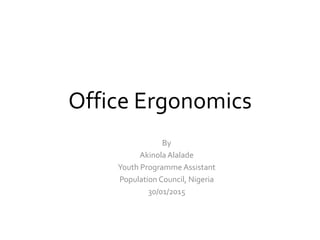
Office Ergonomics
- 1. Office Ergonomics By Akinola Alalade Youth Programme Assistant Population Council, Nigeria 30/01/2015
- 2. Outline • Physical Demands • Ergonomics Definition and Application • Risk Factors • Back Pain: Correct and Incorrect Techniques • Prevention Strategies • Ergonomic Products • References
- 3. Adjusting your workstation to fit your body
- 4. Physical demands • What are the physical demands of your job….
- 5. Ergonomics Definition • Designing the job to fit the worker rather than physically forcing the worker to fit the job1,2,6
- 6. Ergonomics Application • Workstation Design6—(desks, chairs, space, layout) • Work Postures3 — (sitting, standing, reaching, lifting) • Work Organization6 — (Pace, Breaks,Variety) • Tools, Equipment, and Furniture Design—(body size, height, gender, promoting neutral postures, reduced vibration, exposure to acceptable lighting, noise, temperature) • Manual Materials Handling3,7—(lifting, lowering, pulling, pushing, carrying and holding materials) • Work Environment2—(ventilation, noise, temperature & humidity, lighting and vision)
- 7. Risk Factors • Repetitive Movements3,5 – Same joints /muscle groups (Thousands of keystrokes typing, Repeated motions with computer mouse) • Forceful Movements3,5 – Excessive movements for long periods of time (e.g. extended reach) • Fixed or Awkward Postures3,5,7 – Cause fatigue (sitting rigidly for long periods; reaching above shoulder, Leaning forward at your desk,Typing with wrists at an odd angle, Raising shoulders while typing, Reaching to use mouse) • Bending,Twisting and Heavy Lifting3,5,6
- 8. Back Pain: Correct and Incorrect Techniques • Occupations that involve manual physical handling and physical workload are known to predispose people to musculoskeletal disorder.4 • Which one is correct?
- 9. Back Pain: Correct and Incorrect Techniques
- 10. Back Pain: Correct and Incorrect Techniques
- 11. Prevention Strategies • The elbow should be at a comfortable angle while “hanging” at the sides from the shoulders.The shoulders should remain in a relax position while typing.
- 12. Prevention Strategies • Avoid typing with wrists at an odd angles… – keep them in the neutral position, not bent up or down, or side-to-side
- 13. Prevention Strategies • The keyboard should be slightly lower than normal desk height. – If it is not low enough, try raising your chair height. Prevent your legs from dangling by using a footrest.
- 14. Prevention Strategies • Place monitor in front of you, not off at an angle. • Take lots of breaks to stretch and relax. • Hold the mouse lightly. • Keep your hands and arms warm.
- 18. References 1. Ergonomics: The Study of Work OSHA 3125 2000 (Revised) https://www.osha.gov/Publications/osha3125.pdf 2. Environmental Health & Safety 120 Physical Plant Services Bldg. | Stillwater, OK 74078 | 405.744.7241 | All rights reserved OSU-System | OSU-Stillwater | OSU-OKC | OSU-Tulsa | OSU-Okmulgee | OSU-CHS | Accessibility https://ehs.okstate.edu/kopykit/ergo.htm 3. Industrial Accident Prevention Association 2009. All rights reserved. http://www.iapa.ca/main/documents/pdf/freedownloads_pda_intro.p df 4. Ando, S., Ono, Y., Shiamoke, M., Hiratu, S., Hatton, Y., Horr, F., Takeuchi, Y.(2004) ‘Association of self estimated workloads with musculoskeletal symptoms among hospital nurses’. Occupational and Environmental Medicine, 57(3):21-16. 5. Olaogun M O B (1993) Health hazards in Physiotherapy in Hospital setting: A comparactive study. Journal of the Nigeria Society of Physiotherapy. 9(1):12-16 6. Joint Professional Training and Support International http://www.jptsng.org/ 7. Rosecrance, J.C., Crook, T.M.(1998)‘Musculoskeletal disorder: Occupational association and a model for prevention’.Ocupational Health and Safety, 4 :214 - 231.
